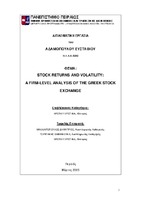| dc.description.abstract | This paper examines the relationship between stock returns and volatility for the Geek Stock Exchange. The significant boom that took place in the Greek equity market in 1999, which turned to be a dramatic bubble for the majority of listed stocks and the majority of active investors, forced us to examine any possible relation between stock returns and volatility. By the end of 1998 there were up to 390.000 end-client (investors) trading codes in the ASE’s trading system. At 31/12/2004 these codes are up to 2.363.000. 1.114.367 new codes (about 50% of today’s existing codes) were added to the system in 1999. This figure shows how important 1999 was in Greek people life, how much their life was influenced by the so called “stock madness” later on. ASE’s General index from about 1.000 points in early 1997 jumped up to 6.500 point by the end of 1999. After that dropped to 1.500 in 2003. At the late 1990s, new laws and institutional reform took place, in terms of trading activity, regulation and organization of the market operation, and the type of companies that could operate in this field (from individual brokers to SA companies). Moreover, 10 years later, the Greek market was included in the developed markets (May 2001), as the number of listed companies increased dramatically, and the deregulation continued, with measures such as the margin account, initiation of the market maker, increase of listing requirements, new markets (EAGAK, NEXA), creation of the derivatives market. Under that scope, it is rather interesting to examine and analyse the relation between changes in stock market volatility and stock returns. | |



